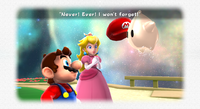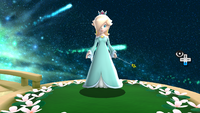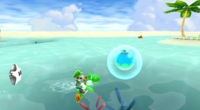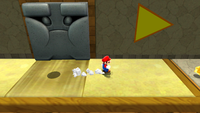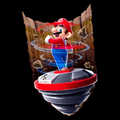Super Mario Galaxy 2
It has been requested that this article be rewritten.
Template:Infobox Super Mario Galaxy 2 is the sequel to Super Mario Galaxy for the Wii. It is the fourth game in the 3-D Mario series. It was released in 2010 on May 23 in North America, May 27 in Japan, June 11 in Europe, July 1 in Australia and December 4 in China. The sequel contains many elements from its predecessor, such as the adventure being in outer space, recurring objects such as Launch Stars, recurring items including the Bee Mushroom, and the elements of gravity. However, the game introduces new elements such as the utilization of Yoshi, new power-ups such as the Cloud Flower, and the use of a guide within the game for beginner players. All releases of the game except for the American version include a beginner's DVD to help players understand the controls and items if they haven't played Super Mario Galaxy. In North America, help for beginners is found on the official website, as well as in the Nintendo Channel.
Story
Every one hundred years, shining stardust falls on Mushroom Kingdom. On this particular day, residents of the Mushroom Kingdom come out and enjoy the stardust being thrown everywhere.
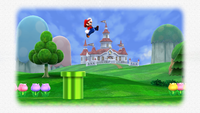
Princess Peach invites Mario to share some cake while watching the shooting stars. On his way to Peach's Castle, Mario finds a lost Baby Luma. The Luma seems to like Mario and jumps into his hat. At Toad Town, Mario discovers a planet-sized Bowser attacking the castle. Bowser explains that he used the power of the Power Stars to become giant. He kidnaps Peach and takes her away, hoping for her to witness his creation of his new galaxy in the center of the universe and bake him some cake. Mario heads to the castle where he finds two Lumas. After seeing Baby Luma with Mario, they offer to aid Mario in his search for Power Stars. One of the Lumas transforms into a Launch Star, which sends Mario to the Sky Station Galaxy. After getting one Power Star, Mario flies to Starship Mario, where he meets Lubba and some more Lumas.
In his adventure, Mario must collect as many Power Stars as he can, so Starship Mario can proceed through six worlds and reach Bowser's main fortress.
After going through several galaxies, fighting off enemies new and old (such as Whomp King and Bugaboom), fighting Bowser twice and eventually blowing up Bowser Jr.'s machine to send him flying into space, Mario fights Bowser for the third time in his gigantic fortress. After Mario defeats him, Bowser falls into a void below. Just when Mario is about to get the last Grand Star, Bowser suddenly returns and eats it, making himself huge again. The characters then fly through a vortex in which Mario must pound meteors toward Bowser as he tries to attack him. Mario defeats him and rescues Princess Peach and the final Grand Star of the game.
Upon returning to Starship Mario, a blue comet appears and transforms, revealing the Comet Observatory. Rosalina then appears, happy to see that Baby Luma was safe. It's also revealed that Lubba and Rosalina have met each other before.
When the Baby Luma heads back to his home, he takes Mario's hat as a souvenir, which takes Mario by surprise. Afterward, Rosalina and the Baby Luma return to the Comet Observatory, and the ship flies off.
With the Comet Observatory gone, Lubba mentions to Mario and Peach that it's time for them to return to their own home. They fly away on Starship Mario and the ending credits begin to roll. During the credits, Bowser is shown in a miniature form near Peach's Castle. After this, World S will be revealed.

If the player collects the first 120 Power Stars and battles Bowser one more time in his fortress, an extra scene is shown after the credits, revealing Rosalina and her Lumas in the Comet Observatory's Library. She plans on telling the Lumas a story about the Green Stars. And with that, a new feature is unlocked in which all the galaxies are visited by green Prankster Comets. From there, the player must hunt down all the Green Stars. Additionally, players can now have Rosalina's head as the icon on the file in which the Power Stars were collected.
If the player successfully finds all of the Green Stars (adding up to 240 Power Stars), the Grandmaster Galaxy will be opened in World S. Additionally, if the player gets that galaxy's Comet Medal and gives Banktoad 9,999 Star Bits, a Prankster Comet will appear at the Grandmaster Galaxy, allowing for the final star to be collected by completing the final, difficult level, The Perfect Run.
If the player succeeds with the very last star, Rosalina will congratulate him/her, and will appear on Starship Mario. The player will also receive a message on the Wii Message Board.
On a side note, when the game is 100% complete, the save file will display a counter, representing how many times the player lost a life (just like in the predecessor). The file will also read 'Master of Galaxies' and have a special platinum crown instead of a gold or silver crown.
Characters
Gameplay Elements
Gameplay is similar to Super Mario Galaxy, with a focus on platforming based on and around 3-D planets of varying sizes and with many different types of surfaces. Power-ups, such as the Bee Mushroom, Boo Mushroom, Spring Mushroom, and Fire Flower make a return, along with new ones such as the Rock Mushroom and the Cloud Flower, as well as various enemies and Airships. Launch Stars reappear for interplanetary navigation, along with a Luma and Mario's spin action. Additionally, the concept of "Dark Matter" appears as the medium of which Cosmic Clones are composed, and as a portal through which Airships emerge from. 2-D stages featured in Super Mario Galaxy are also included in Super Mario Galaxy 2, introducing many new features. The game has only 3 file slots to use, unlike the 6 files in the preceding game.
One of the more notable additions in Super Mario Galaxy 2 is the inclusion of Yoshi. If Mario were to discover a Yoshi egg, he would merely crack it to release and use Yoshi. Yoshi will change colors when eating either a Dash Pepper, Blimp Berry or Bulb Berry; a Dash Yoshi darts at rapid speeds, a Blimp Yoshi inflates and floats upwards, and a Bulb Yoshi lights up and shows hidden paths for a certain amount of time, respectively. When utilizing Yoshi, the player's Wii Remote cursor turns into a red sphere that detects targets for Yoshi's tongue. Using the cursor allows Yoshi to swallow enemies and swing from special flowers.
Elements from older games are also included in the new game. These elements include a remix of Super Mario Bros.'s overworld theme (which is originally heard in Toy Time Galaxy from the predecessor, Super Mario Galaxy), a galaxy that is reminiscent to Giant Land from Super Mario Bros. 3, a remix of the second overworld theme from Super Mario World, the checkpoint flag from New Super Mario Bros. Wii, and a remix of the main theme and slide theme from Super Mario 64. Red and blue platforms from Super Mario Sunshine will also be available, though they change sides when Mario spins in mid-air.
It is noteworthy to mention that Super Mario Galaxy 2 features a singular hub, different from any Mario 3-D game. For traveling between different galaxies Mario will use a planet shaped like his head, Starship Mario. Starship Mario can still be explored, much like the Comet Observatory, although it is smaller. The game has a total of 242 stars to collect, including 120 Power Stars, 120 Green Stars and an extra 2 Power Stars in Grandmaster Galaxy.
Multiplayer from the original Super Mario Galaxy reappears, but instead of being another star cursor, the second player is a Co-Star Luma. The second player in Super Mario Galaxy 2 can stun enemies and pick up Star Bits like in Super Mario Galaxy, but now it can pick up coins (including Purple Coins) and mushrooms, defeat enemies by spinning, stop the Star Ball (while player 1 is riding on it), activate checkpoints, and flip switches.

Super Mario Galaxy 2 features ways to help players during gameplay similar to the Super Guide mode seen in New Super Mario Bros. Wii. The player may request to the Tip Network, which it is a short demonstration of Mario taking some actions to progress on certain level. Another way the game offers is the Cosmic Guide mode. If the player finds a very difficult obstacle on his or her way, an entity known as the Cosmic Spirit will ask Mario if he needs some help. Activating this mode, Mario will pass automatically through the level to find the Star. The player may stop this mode by pressing the ![]() , though once the player has chosen this mode, he/she will finish a level by getting a Bronze Star instead of one gold. The player must play through the level without the Cosmic Guide in order to gain a gold Star.
, though once the player has chosen this mode, he/she will finish a level by getting a Bronze Star instead of one gold. The player must play through the level without the Cosmic Guide in order to gain a gold Star.
In addition to that, unlike in Super Mario Galaxy, the player can now switch between playing as Mario or playing as Luigi in certain levels. If the player clears Bowser's Galaxy Generator, Luigi can be played as in any level.
Enemies
New Enemies
Returning Enemies
* - Enemies which first appeared in Super Mario Galaxy.
Items
Power Ups
This game introduces the Cloud Flower, the Spin Drill and the Rock Mushroom. The Ice Flower and the Red Star are the only Power-Ups from the first game not to make a comeback appearance in the sequel. All of the Power-Ups except for the Rainbow Star appear in the Engine Room of Starship Mario, though none can be used, as they are contained as souvenirs in small glass domes which cannot be penetrated.
- Cloud Mario.jpg
Cloud Mario using a Cloud Flower.
Mario using a Spin Drill.
- RockMario.jpg
Rock Mario after collecting a Rock Mushroom.
- BeeMario.jpg
Bee Mario after collecting a Bee Mushroom.
Fire Mario using a Fire Flower.
- BooMario.jpg
Boo Mario after collecting a Boo Mushroom.
- Springmario.jpg
Spring Mario after collecting a Spring Mushroom.
- SMG RainbowMario.jpg
Rainbow Mario using a Rainbow Star.
Power Up Locations
Cloud Flower
- Starship Mario
- Fluffy Bluff Galaxy
- Puzzle Plank Galaxy, secret star
- Cloudy Court Galaxy
- Starshine Beach Galaxy, star 2
- Shiverburn Galaxy
- Bowser Jr.'s Boom Bunker
- Throwback Galaxy, star 2
- Bowser's Galaxy Generator
- Twisty Trials Galaxy
- Grandmaster Galaxy
Spin Drill
- Spin-Dig Galaxy
- Cosmic Cove Galaxy, star 2
- Supermassive Galaxy
- Flipsville Galaxy, star 2
- Bowser's Galaxy Generator
Rock Mushroom
- Boulder Bowl Galaxy
- Freezy Flake Galaxy, star 2
- Melty Monster Galaxy, star 2
Bee Mushroom
Fire Flower
- Rightside Down Galaxy
- Freezy Flake Galaxy, star 1
- Upside Dizzy Galaxy
- Slipsand Galaxy, star 1, 3
- Battle Belt Galaxy
Boo Mushroom
- Boo Moon Galaxy, star 2
Spring Mushroom
- Chompworks Galaxy, star 2
Rainbow Star
- Sky Station Galaxy
- Yoshi Star Galaxy, comet star
- Spin-Dig Galaxy, star 1
- Shiverburn Galaxy, comet star
Yoshi and his Fruits
These are Yoshi's powerups and the locations they are in, along with the locations that Yoshi himself is in.
- Marioyoshireed.png
Dash Yoshi after eating a Dash Pepper
- MarioandBaloonYoshi.jpg
Blimp Yoshi after eating a Blimp Fruit
- MarioandLightYoshi.jpg
Bulb Yoshi after eating a Bulb Berry
Yoshi Locations
- Starship Mario
- Yoshi Star Galaxy
- Hightail Falls Galaxy
- Tall Trunk Galaxy, star 1
- Haunty Halls Galaxy, star 1
- Beat Block Galaxy, comet star
- Bowser Jr.'s Fearsome Fleet
- Starshine Beach Galaxy
- Sweet Mystery Galaxy
- Flash Black Galaxy
- Bowser's Galaxy Generator
- Twisty Trials Galaxy, comet star
- Grandmaster Galaxy
Fruit Locations
Dash Pepper
Blimp Fruit
- Tall Trunk Galaxy, star 1
- Starshine Beach Galaxy, star 1
- Flash Black Galaxy
- Bowser's Galaxy Generator
Bulb Berry
Galaxies
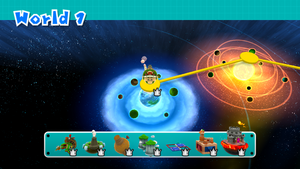
All forty-nine Galaxies can be accessed via the Grand World Map with Starship Mario. There are seven more galaxies in this game than the first game.
World 1
- Sky Station Galaxy
- Yoshi Star Galaxy
- Spin-Dig Galaxy
- Fluffy Bluff Galaxy
- Flip-Swap Galaxy
- Rightside Down Galaxy
- Bowser Jr.'s Fiery Flotilla
World 2
- Puzzle Plank Galaxy
- Hightail Falls Galaxy
- Boulder Bowl Galaxy
- Cosmic Cove Galaxy
- Wild Glide Galaxy
- Honeybloom Galaxy
- Bowser's Lava Lair
World 3
- Tall Trunk Galaxy
- Cloudy Court Galaxy
- Haunty Halls Galaxy
- Freezy Flake Galaxy
- Rolling Masterpiece Galaxy
- Beat Block Galaxy
- Bowser Jr.'s Fearsome Fleet
World 4
- Supermassive Galaxy
- Flipsville Galaxy
- Starshine Beach Galaxy
- Chompworks Galaxy
- Sweet Mystery Galaxy
- Honeyhop Galaxy
- Bowser's Gravity Gauntlet
World 5
- Space Storm Galaxy
- Slipsand Galaxy
- Shiverburn Galaxy
- Boo Moon Galaxy
- Upside Dizzy Galaxy
- Fleet Glide Galaxy
- Bowser Jr.'s Boom Bunker
World 6
- Melty Monster Galaxy
- Clockwork Ruins Galaxy
- Throwback Galaxy
- Battle Belt Galaxy
- Flash Black Galaxy
- Slimy Spring Galaxy
- Bowser's Galaxy Generator
World S
- Mario Squared Galaxy
- Rolling Coaster Galaxy
- Twisty Trials Galaxy
- Stone Cyclone Galaxy
- Boss Blitz Galaxy
- Flip-Out Galaxy
- Grandmaster Galaxy
Bosses
Twenty bosses appear in the game. Some of them are fought more than once. The numbers below include Prankster Comet encounters.
- Peewee Piranha ×2
- Giga Lakitu ×1
- Digga-Leg ×2
- Gobblegut ×2
- Bugaboom ×1
- Rollodillo ×1
- Sorbetti ×1
- Megahammer ×2
- Glamdozer ×1
- Squizzard ×2
- Prince Pikante ×1
- Bowser Jr.'s Boomsday Machine ×2
- Whomp King ×1
- Fire Gobblegut ×1
- Giant Bowser ×3
- Dino Piranha ×4
- King Kaliente ×4
- Major Burrows ×3
- Bouldergeist ×2
- Fiery Dino Piranha ×2
Note: There is a Green Star on Major Burrows's planet and Bouldergeist's arena. In these situations, the player can choose to ignore the two bosses and go for the Green Star instead.
Development
The development of Super Mario Galaxy 2 started as soon as the first Super Mario Galaxy was released. Many of the ideas were based on those shown in the first game, which, for example, included moving or adding new stars in the levels. The project was initially called Super Mario Galaxy 1.5. The development of the new version of the game lasted a year; however, Miyamoto realized that the new game was beginning to overflow with new elements and ideas. Therefore, the team decided to create a real Super Mario Galaxy sequel rather than a new version of the original installment.[1] The development of the sequel then lasted two and half years.[2]
The game was revealed at E3 2009, along with New Super Mario Bros. Wii. Although the game was far along in development, it was held back to 2010 due to the release of New Super Mario Bros. Wii in November 2009.Template:Refneeded According to Shigeru Miyamoto, 90% of the features in the game would be new, whereas the remaining 10% were already introduced or featured in the original Super Mario Galaxy. Shigeru Miyamoto noted, "Really what we ended up with is more than 90% of what you'll see in Galaxy 2 is brand new. I'd say closer to 95, maybe even 99%. One of the new things was the inclusion of Yoshi, and also the use of the drill to open up and drill through stages."[3] On the other hand, Miyamoto stated in an interview that he wanted to go with as little story as possible for Super Mario Galaxy 2.[4]
CEO of Nintendo America Reggie Fils-Aime stated that Super Mario Galaxy 2 would be more challenging regarding its predecessor. It was hinted that the new game would implement a tool-assisted guide, similar to the Super Guide from New Super Mario Bros Wii. It was eventually confirmed, although it worked differently. Beginner players could use the Cosmic Guide mode (activated when encountering the Cosmic Spirit) or the Tip Network to learn moves and hints during gameplay. Japanese, European and Australian boxes came with a special DVD to help players to know basic and expert techniques of the game.
Super Mario Galaxy 2: Original Soundtrack
- Main article: Super Mario Galaxy 2: Original Soundtrack
A soundtrack for the game has been released. It is a two-disc edition exclusive to Club Nintendo members in Japan which holds all seventy songs from the game.
Reception
Super Mario Galaxy 2 has received extremely positive reviews. EDGE magazine has given the game a perfect score of 10 out of 10, being the third Mario game so far to receive such rating (the others were Super Mario 64 and Super Mario Galaxy). Official Nintendo Magazine grants it a 97%, while Game Informer has given the game 9.25 out of 10. Nintendo Power gave it a 9.5 out of 10. IGN and Gamespot granted the game a perfect 10/10, as well as GamesRadar. Gamespot also gave the game the Best Platforming Award and the Best Wii Game Award of 2010. IGN named it the Best Wii Game of all time. Gametrailers has given a 9.7 from 10, while Famitsu a 37 out of 40. GamePro gave four and half stars, X-Play gave it a perfect five out of five stars, and 1UP.com an "A" rating. Nintendo Power gave the game many awards in addition to the near perfect 9.5 rating, including the Overall Game of the Year Award (Readers), Best Wii Game of 2010 (Staff and Readers), and more.
Media
Quotes
- Main articles: List of Quotes in Super Mario Galaxy 2, Super Mario Galaxy 2/Quotes
Glitches
- Main article: Super Mario Galaxy 2/Glitches
Beta Elements
- Main article: Super Mario Galaxy 2/Beta elements
Gallery
Staff
- Main article: Super Mario Galaxy 2/Staff
References to Other Games
- Super Mario Bros.: Supermassive Galaxy's music, which is itself a remix of Toy Time Galaxy's music from the first game, originated from this game's overworld music. Other music from this game returned from Super Mario Galaxy as well.
- Super Mario Bros. 3: Supermassive Galaxy is similar to Giant Land from this game, as the two are of massive size and feature giant versions of common items and enemies.
- Super Mario World: Yoshi, who first appeared in this game, is playable in Super Mario Galaxy 2, and the percussion sounds heard when riding on Yoshi are re-used. Additionally, this game's athletic theme returns as Hightail Falls Galaxy's music, and the Ghost House theme returns as Haunty Halls Galaxy's music. Also, the sound effect that is heard when a P-Switch's effect is about to run out is used in the bonus areas of Super Mario Galaxy 2, and the sound effect heard when passing through a door in this game is used when opening a door in Boo Moon Galaxy.
- Super Mario 64: The music from The Princess's Secret Slide from this game (and its remake) is used for Tall Trunk Galaxy and Rolling Coaster Galaxy. The "Bowser's Road" theme is remixed once again. Also, Throwback Galaxy from Super Mario Galaxy 2 is a replica of Whomp's Fortress, and its boss, the Whomp King, is fought there. Both games start with Peach sending a letter to Mario involving cake. Additionally, the "Inside the Castle Walls" theme can be heard when rescuing Peach and the final Grand Star in Super Mario Galaxy 2. The Rainbow Star theme is remixed once again from the Wing Cap and Vanish Cap theme. Finally, Mario says, "Thank you so much for playing my game!" after the ending credits, just as he did in this game.
- Super Mario Sunshine: Starshine Beach Galaxy is based on some elements from this game. Twisty Trials Galaxy is a replica of a level in Ricco Harbor. The red and blue flipping platforms return, although they work differently. Piantas also return.
- Super Mario Galaxy: Many planets and bosses from this game return, and parts of Dino Piranha's egg are orbiting Peewee Piranha's planet. A few bosses are based on bosses from the prequel, like Peewee Piranha to Dino Piranha and Digga-Leg to Megaleg. Many bosses in Super Mario Galaxy are also featured in the Boss Blitz Galaxy, such as Major Burrows and Bouldergeist. Also, the last boss before Bowser's final battle is a fiery version of a boss fought before in the game, like in Super Mario Galaxy. Most of this game's bosses are fought in Super Mario Galaxy 2, and many elements from this game return. Both games start with the Star Festival. In the Japanese version, the Toad Brigade Captain introduces himself as the Commanding Officer Toad although he didn't have any title in the previous game, referring to how the Toad Brigade was ranked up after the ending of Super Mario Galaxy.
- New Super Mario Bros. Wii: The Midway Flag returns from this game, and the Cosmic Guide and Tip Network are based on the Super Guide and Hint Movies from this game, respectively. Also, the world maps are based on the one from this game. In both games, Bowser is giant, and the final battle is divided in two different parts, the later having a bigger Bowser. The model for the Koopalings' cake reappears in Super Mario Galaxy 2's credits. Additionally, when players collect all the coins in a certain time limit that were accessed by a switch in Super Mario Galaxy 2, the audience claps in the same fashion they did in this game.
References in Later Games
- Donkey Kong Country Returns: Flip-Out Galaxy's concept is back (but slighty changed) for the Switcheroo level.
- Super Mario (Nintendo 3DS): Comet Medals, or similarly-designed items, will appear.
Names in Other Languages
References
- ^ Nintendo Everything – Our second language is Nintendo++ » Blog Archive » At one point, Super Mario Galaxy 2 was Super Mario Galaxy 1.5 "As soon as the project was over, we started making something that we might call version 1.5. We did things like moving or adding stars to levels that were already available... we realized that there were too many things to fit into a version 1.5. That made us realize we should start from scratch and make Super Mario Galaxy 2." - Miyamoto during Iwata Asks: Super Mario Galaxy 2 interview
- ^ Iwata Asks: Super Mario Galaxy 2 details
- ^ E3: Miyamoto: Galaxy 2 Is As Big As The Original
- ^ Shigeru Miyamoto Interview at Wired.com
External Links
- Official American Website
- Official Japanese Website
- Official Australian Website
- Official European Website
- Wii's channel on Youtube - Super Mario Galaxy 2
- Offical Chinese Website (TW)
- Offical Chinese Website (HK)

